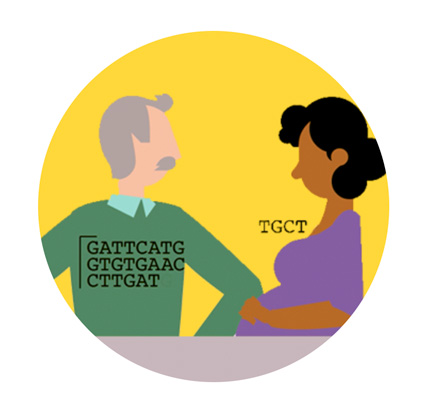
Genomic testing in healthcare is here to stay. Use of testing is increasing, not only in the traditional sense (think hereditary cancer or prenatal genetics), but also outside the doctor’s office. It is estimated that the number of people participating in consumer genomic testing will grow from 26 million at the start of 2019 to over 100 million by 2021 (MIT Review 2019, Feero 2020).
These consumers are obtaining information about future health risks from tests they’ve accessed themselves but may have gotten more (or less!) information than they’d bargained for. They may come to you, their provider, to ask for your help understanding the results. Is your understanding of consumer genomic testing current? Do you make assumptions about the usefulness of these tests? To help you understand where this testing stands, we’ll discuss five misconceptions about consumer genomics.
1. Results are not useful for making healthcare decisions
The marketplace for consumer genomic tests has changed significantly in the past few years. While this may have been true several years ago, some results may actually be as reliable and useful as those from tests ordered by a clinician. It can be helpful to think about purchased genetic tests as falling into two categories: direct-to-consumer (DTC) and consumer-driven testing. DTC tests are classified by the FDA as in vitro diagnostics and are regulated as medical devices. Consumer-driven tests are performed at diagnostic laboratories and ordered by a physician (often one affiliated with the lab). Consumer-driven tests are often referred to as “clinical grade” because these are the same labs genetic specialists (and other providers) use when there is a clinical indication for genetic testing.
As the DTC testing space has evolved, the FDA has granted approval for DTC companies to provide testing for very specific health risks. Examples are the three Ashkenazi Jewish founder mutations in the BRCA genes and two specific variants associated with Parkinson’s disease risk. Pharmacogenomics, or individual response to certain medications based on genomic variants, is increasingly being incorporated into these tests as well. These types of DTC results can guide management decisions but should be clinically confirmed.
Also new is the way in which diagnostic labs are increasing access to their tests. Consumers interested in proactive health testing, such as for cancer risk, can obtain a hereditary cancer panel. This means consumers now have access to the same test options as providers do. A third-party provider, often a doctor employed by the company, reviews the request and orders the test. Positive results from this type of testing do not need clinical confirmation, but referral to a genetic specialist is recommended.
2. Results will not provide useful information about common complex diseases
After the Human Genome Project was completed, researchers had access to the entire human DNA sequence, leading to discovery of numerous small changes throughout the genome associated with tiny increases in risk for common diseases. We now have the computing power to assess these variants and consider them together as a group. The data from these analyses are called polygenic risk scores, and many studies appear to be sufficiently powered to show good correlation with the disease of interest. While it is not yet standard of care to consider polygenic risk scores when making management decisions, their predictive value is improving, and clinicians will soon be using polygenic risk scores in conjunction with other clinical factors to ascertain risk of certain conditions such as type 2 diabetes, breast cancer and cardiovascular disease. Breast cancer screening recommendations, for example, may change to include screening breast MRI for women when personal and familial risk factors and a polygenic risk score point in the direction of higher lifetime risk.
3. Ancestry testing does not provide health information
The test most commonly purchased by consumers is ancestry testing. While ancestry testing is mainly considered to have entertainment value, or to be of importance sociologically, there is an important exception. Third party services will accept raw test data on variants from ancestry companies and provide the consumer with information about health risks. Recently, some ancestry companies are providing an option to add on health risk variants. Consumers may not realize they will be provided this information if an opt-out process is used. It is important to note that variant interpretation by these services can be wildly inaccurate, with one clinical lab that performs confirmatory testing demonstrating a 40% false positive rate. If you see a third party result that is concerning, recognize that confirmatory testing may help clarify risk for your patient.
4. Patients understand the benefits and limitations of the test they ordered
Many companies have strong empowerment messaging on their websites, encouraging individuals to know their genomic risks and take charge of their health. And while they can learn important information to make behavioral and management changes for their health, they may not understand the limitations of the tests. In DTC testing, a negative result for a certain condition does not rule out risk, because often only a handful of common variants are analyzed. Because these variants were studied primarily in white populations of European descent, residual risk in diverse populations is even more of an issue. With consumer-driven testing through a diagnostic lab, a negative result may be more reassuring, but not all genes related to the condition of interest may have been analyzed. If you or your patient remains concerned about risk of a certain condition, continue to rely on personal and family history and clinical assessments.
5. You won’t need to deal with this
With the ongoing consolidation of hospitals and medical practices into large regional healthcare systems, genomic information will increasingly be available in the electronic medical record. This is because many large health systems have implemented genomic research projects, linking patient medical records (phenotype) with genomic test data (genotype). One provider in your organization may have enlisted your patient as a research participant, and now this information is available to you and your patient as you provide continuing care and guidance on management of future health risks. In the near future, all providers may be expected to factor in genomic screening with other health screening data and develop management plans.
So you can see that consumer genomic testing has more clinical implications than it did even a few years ago. Providers can no longer say across the board that it was just all in good fun. Granted, some tests such those from DTC companies are still primarily for ancestry or entertainment purposes, and patients may be disappointed to learn this. Even if risk for a health-related condition is identified through DTC testing, clinical confirmation will be needed. Tests from diagnostic labs used by clinicians and large scale genomic research projects can provide clinically useful information. However, patients may not have had comprehensive pre-test counseling, or the test may not have addressed all of their goals for testing. Being able to assess what type of test was done and what information it included is important to understanding its impact on diagnosis, management, or prevention of a disease. Keep in mind that genetic specialists continue to be a valuable resource for you and your patients to navigate interpretation and management of these results.

Genomic Testing for the Healthy Individual
Learn how to elicit patient motivations for genomic testing and to assess if a particular genomic test is a good fit for their concerns.
Resources
Accessing Genetic Services (JAX). Lists tools and websites to help find genetic professionals and communicate with patients about a genetics referral.
Comparing Direct-to-Consumer Tests (DNA Today podcast). July 2020.
Direct-to-Consumer Genetic Testing FAQ (National Human Genome Research Institute). February 2022.
References
Regalado A. More than 26 million people have taken an at-home ancestry test. MIT Technology
Review. February 11, 2019. Feero WG, Wicklund CA. Consumer Genomic Testing in 2020 JAMA. 2020; 323(15):1445-.